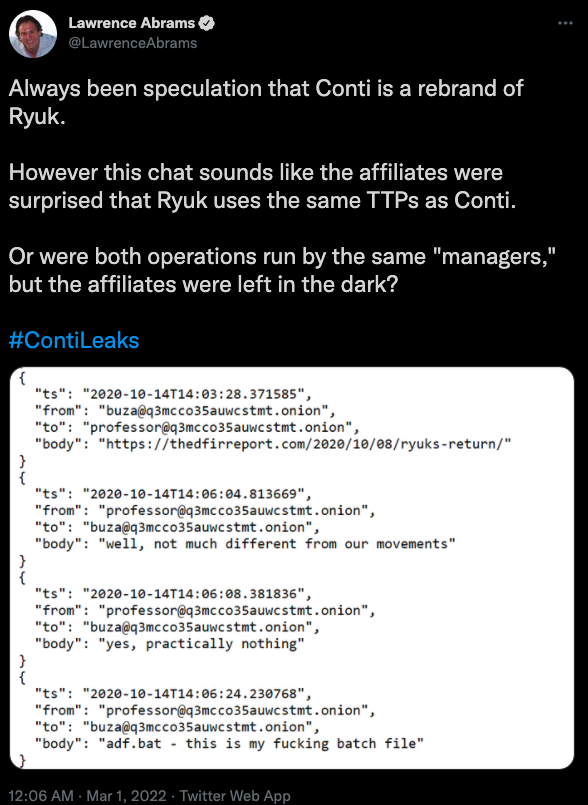Earlier this week, a Ukrainian security researcher leaked almost two years’ worth of internal chat logs from Conti, one of the more rapacious and ruthless ransomware gangs in operation today. Tuesday’s story examined how Conti dealt with its own internal breaches and attacks from private security firms and governments. In Part II of this series we’ll explore what it’s like to work for Conti, as described by the Conti employees themselves.

The Conti group’s chats reveal a great deal about its internal structure and hierarchy. Conti maintains many of the same business units as a legitimate, small- to medium-sized enterprise, including a Human Resources department that is in charge of constantly interviewing potential new hires.
Other Conti departments with their own distinct budgets, staff schedules, and senior leadership include:
–Coders: Programmers hired to write malicious code, integrate disparate technologies
–Testers: Workers in charge of testing Conti malware against security tools and obfuscating it
–Administrators: Workers tasked with setting up, tearing down servers, other attack infrastructure
–Reverse Engineers: Those who can disassemble computer code, study it, find vulnerabilities or weaknesses
–Penetration Testers/Hackers: Those on the front lines battling against corporate security teams to steal data, and plant ransomware.
Conti appears to have contracted out much of its spamming operations, or at least there was no mention of “Spammers” as direct employees. Conti’s leaders seem to have set strict budgets for each of its organizational units, although it occasionally borrowed funds allocated for one department to address the pressing cashflow needs of another.
A great many of the more revealing chats concerning Conti’s structure are between “Mango” — a mid-level Conti manager to whom many other Conti employees report each day — and “Stern,” a sort of cantankerous taskmaster who can be seen constantly needling the staff for reports on their work.
In July 2021, Mango told Stern that the group was placing ads on several Russian-language cybercrime forums to hire more workers. “The salary is $2k in the announcement, but there are a lot of comments that we are recruiting galley slaves,” Mango wrote. “Of course, we dispute that and say those who work and bring results can earn more, but there are examples of coders who work normally and earn $5-$10k salary.”
The Conti chats show the gang primarily kept tabs on the victim bots infected with their malware via both the Trickbot and Emotet crimeware-as-a-service platforms, and that it employed dozens of people to continuously test, maintain and expand this infrastructure 24 hours a day, 7 days a week.
Conti members referred to Emotet as “Booz” or “Buza,” and it is evident from reading these chat logs that Buza had its own stable of more than 50 coders, and likely much of the same organizational structure as Conti.
According to Mango, as of July 18, 2021 the Conti gang employed 62 people, mostly low-level malware coders and software testers. However, Conti’s employee roster appears to have fluctuated wildly from one month to the next. For example, on multiple occasions the organization was forced to fire many employees as a security precaution in the wake of its own internal security breaches.
In May 2021, Stern told Mango he wanted his underlings to hire 100 more “encoders” to work with the group’s malware before the bulk of the gang returns from their summer vacations in Crimea. Most of these new hires, Stern says, will join the penetration testing/hacking teams headed by Conti leaders “Hof” and “Reverse.” Both Hof and Reverse appear to have direct access to the Emotet crimeware platform.
On July 30, 2021, Mango tells stern the payroll has increased to 87 salaried employees, with more hires on the way. But trying to accurately gauge the size of the Conti organization is problematic, in part because cybersecurity experts have long held that Conti is merely a rebrand of another ransomware strain and affiliate program known as Ryuk.
First spotted in 2018, Ryuk was just as ruthless and mercenary as Conti, and the FBI says that in the first year of its operation Ryuk earned more than $61 million in ransom payouts.
“Conti is a Targeted version of Ryuk, which comes from Trickbot and Emotet which we’ve been monitoring for some time,” researchers at Palo Alto Networks wrote about Ryuk last year. “A heavy focus was put on hospital systems, likely due to the necessity for uptime, as these systems were overwhelmed with handling the ongoing COVID-19 pandemic. We observed initial Ryuk ransom requests ranging from US$600,000 to $10 million across multiple industries.”
On May 14, 2021, Ireland’s Health Service Executive (HSE) suffered a major ransomware attack at the hands of Conti. The attack would disrupt services at several Irish hospitals, and resulted in the near complete shutdown of the HSE’s national and local networks, forcing the cancellation of many outpatient clinics and healthcare services. It took the HSE until Sept. 21, 2021 to fully restore all of its systems from the attack, at an estimated cost of more than $600 million.
It remains unclear from reading these chats how many of Conti’s staff understood how much of the organization’s operations overlapped with that of Ryuk. Lawrence Abrams at Bleeping Computer pointed to an October 2020 Conti chat in which the Emotet representative “Buza” posts a link to a security firm’s analysis of Ryuk’s return.

“Professor,” the nickname chosen by one of Conti’s most senior generals, replies that indeed Ryuk’s tools, techniques and procedures are nearly identical to Conti’s.
“adf.bat — this is my fucking batch file,” Professor writes, evidently surprised at having read the analysis and spotting his own code being re-used in high-profile ransomware attacks by Ryuk.
“Feels like [the] same managers were running both Ryuk and Conti, with a slow migration to Conti in June 2020,” Abrams wrote on Twitter. “However, based on chats, some affiliates didn’t know that Ryuk and Conti were run by the same people.”
ATTRITION
Each Conti employee was assigned a specific 5-day workweek, and employee schedules were staggered so that some number of staff was always on hand 24/7 to address technical problems with the botnet, or to respond to ransom negotiations initiated by a victim organization.
Like countless other organizations, Conti made its payroll on the 1st and 15th of each month, albeit in the form of Bitcoin deposits. Most employees were paid $1,000 to $2,000 monthly.
However, many employees used the Conti chat room to vent about working days on end without sleep or breaks, while upper managers ignored their repeated requests for time off.
Indeed, the logs indicate that Conti struggled to maintain a steady number of programmers, testers and administrators in the face of mostly grueling and repetitive work that didn’t pay very well (particularly in relation to the earnings of the group’s top leadership). What’s more, some of the group’s top members were openly being approached to work for competing ransomware organizations, and the overall morale of the group seemed to fluctuate between paydays.
Perhaps unsurprisingly, the turnover, attrition and burnout rate was quite high for low-level Conti employees, meaning the group was forced to constantly recruit new talent.
“Our work is generally not difficult, but monotonous, doing the same thing every day,” wrote “Bentley,” the nickname chosen by the key Conti employee apparently in charge of “crypting” the group’s malware — ensuring that it goes undetected by all or at least most antivirus products on the market.
Bentley was addressing a new Conti hire — “Idgo” — telling him about his daily duties.
“Basically, this involves launching files and checking them according to the algorithm,” Bentley explains to Idgo. “Poll communication with the encoder to receive files and send reports to him. Also communication with the cryptor to send the tested assembly to the crypt. Then testing the crypt. If jambs appear at this stage , then sending reports to the cryptor and working with him. And as a result – the issuance of the finished crypt to the partner.”
Bentley cautioned that this testing of their malware had to be repeated approximately every four hours to ensure that any new malware detection capability added to Windows Defender — the built-in antivirus and security service in Windows — won’t interfere with their code.
“Approximately every 4 hours, a new update of Defender databases is released,” Bentley told Idgo. “You need to work for 8 hours before 20-21 Moscow time. And career advancement is possible.” Idgo agrees, noting that he’d started working for Conti a year earlier, as a code tester.

OBSERVATIONS
The logs show the Conti gang is exceedingly good at quickly finding many potential new ransomware victims, and the records include numerous internal debates within Conti leadership over how much certain victim companies should be forced to pay. They also show with terrifying precision how adeptly a large, organized cybercrime group can pivot from a single compromised PC to completely owning a Fortune 500 company.
As a well-staffed “big game” killing machine, Conti is perhaps unparalleled among ransomware groups. But the internal chat logs show this group is in serious need of some workflow management and tracking tools. That’s because time and time again, the Conti gang lost control over countless bots — all potential sources of ransom revenue that will help pay employee salaries for months — because of a simple oversight or mistake.
Peppered throughout the leaked Conti chats — roughly several times each week — are pleadings from various personnel in charge of maintaining the sprawling and constantly changing digital assets that support the group’s ransomware operation. These messages invariably relate to past-due invoices for multiple virtual servers, domain registrations and other cloud-based resources.
On Mar. 1, 2021, a low-level Conti employee named “Carter” says the bitcoin fund used to pay for VPN subscriptions, antivirus product licenses, new servers and domain registrations is short $1,240 in Bitcoin.
“Hello, we’re out of bitcoins, four new servers, three vpn subscriptions and 22 renewals are out,” Carter wrote on Nov. 24, 2021. “Two weeks ahead of renewals for $960 in bitcoin 0.017. Please send some bitcoins to this wallet, thanks.”
“Forgot to pay for the anchor domain, and as a result, when trying to renew it was abused and we /probably/ fucked up the bots,” Carter wrote to Stern on Sept. 23, 2020.
As part of the research for this series, KrebsOnSecurity spent many hours reading each day of Conti’s chat logs going back to September 2020. I wish I could get many of those hours back: Much of the conversations are mind-numbingly boring chit-chat and shop talk. But overall, I came away with the impression that Conti is a highly effective — if also remarkably inefficient — cybercriminal organization.
Some of Conti’s disorganized nature is probably endemic in the cybercrime industry, which is of course made up of criminals who are likely accustomed to a less regimented lifestyle. But make no mistake: As ransomware collectives like Conti continue to increase payouts from victim organizations, there will be increasing pressure on these groups to tighten up their operations and work more efficiently, professionally and profitably.
“We have all the opportunities and conditions, we just need to be more professional,” Mango wrote Stern on Aug. 27, 2021. “And we constantly have one or the other: Either we write nonsense in chats, or we don’t answer patients [victims] for half a day. Naturally, our affiliates are nervous after that.”
If you liked this story, please check out Part III in this series, which examines how Conti secured access to the cyber weaponry needed to subvert the security of their targets, as well as how the team’s leaders approached ransom negotiations with their victims.
Part IV: Cryptocrime explores different schemes that Conti pursued to invest in and steal cryptocurrencies.




This research is much appreciated. Thanks for sharing.
First
I find it an interesting reveal (predictable I guess) that the corporate environment is abusive and is seeped in disloyalty and distrust. That is the personality of larceny. It actually surprises me they can keep it this well organized. Life and work in the Black Sea nations must be abhorrent if folks with these skills have to be thieves and cons to have a day job. It’s only a step or two above hooking and self-pimping to keep a drug habit alive. Predation and self-degradation are two sides of the same personality.
“In May 2021, Stern told Mango he wanted his underlings to hire 100 more “encoders” to work with the group’s malware before the bulk of the gang returns from their summer vacations in Crimea”
Well, it looks like Conti management respects to some degree their employees’ life-work balance.
how are you getting “Black Sea Nations” out of this? if they vacation in Crimea and work to moscow time, they’re Russian, it appears evident.
Apparently he considers Russia a black sea nation, at least for the moment.
First comment here
“However, many employees used the Conti chat room to vent about working days on end without sleep or breaks, while upper managers ignored their repeated requests for time off.”
I feel really bad for them!
Every office has a ‘Stern’.
Just wondering, if as much is known about these actors as if seems, do we know where they work? (location)Maybe that information would help “slow” them down? If their turnover is so high because pay so low, for long hours, it seems someone ought to be able turn some of these actors into a option against the group. Maybe if paybacks are very, very high, it would be more of a deterrent or more painful, to carry on as normal. Just asking for a friend
This whole thing would make a real good Netflix movie series
Better yet, do a Russian version of The Office. Who will play Mikhail Scottrova?
That’s one of the funniest things I’ve ever read. Thanks for that I nearly fell out of my chair.
https://www.wsj.com/articles/u-s-to-target-crypto-ransomware-payments-with-sanctions-11631885336
Still can’t believe Ryuk/Conti are not on the US Treasury’s OFAC SDN (Sanctions List).
If Russia keeps pressing, and Conti is revealed to be more and more as state-sponsored… the next round of sanctions will be to add Ransomware groups from Russia to the SDN too.
Previous debate on banning ransom payments using cryptocurrency was different. Back then only smaller nation-state sponsored cybercrime actors were on the sanction list. Lazarus group because of ties to North Korea. Iranian threat actors. And a few Russian groups.
This new debate should be about sanctioning a significant cash flow to the Russian economy.
If nobody wants to talk about sanctioning Russia’s energy exports, because it would hurtcountries who import Russian oil and gas… We need to talk about the huge Russian shadow economy.
Russia is the world’s largest exporter of decryption keys. They get paid up to millions of dollars for each time they are used.
Probably time to sanction those exports.
Cryptocurrency is a great concept with evil results and bad side-effects energy-wise. Whoever devises a way to cut Russia out of cryptocurrency flow deserves a Nobel for peace.
Cryptocurrency is a great concept with evil results and bad side-effects energy-wise. Whoever could devise a way to cut Russia out of cryptocurrency flow should get a Nobel for peace.
great job
Wonder why they were chatting in English?
English is the standard language for business. Even criminal Enterprise. If it’s large enough for a full time HR dept and administrative staff, people speak English. Even in Russia.
They were speaking in Russian. The logs have been translated to English.
No, they are not chatting in English, these chats were translated from Russian.
They weren’t. It was virtually all in Russian. The screenshot you see at the top is just a Google-translated version of the chats, I believe.
I get that the ‘playing field’ is asymmetrical but can’t we have stories of the West fighting the same battle? It may even be agit-prop.
This is fascinating
Fascinating!
Do new hires of Conti have to sign a no compete agreement? Can they be sued if they take malware intellectual property created at Conti to another “firm”?
Sue? Guido takes care of everything here.
how many “employees” has conti group aproxly?
“Indeed, the logs indicate that Conti struggled to maintain a steady number of programmers, testers and administrators in the face of mostly grueling and repetitive work that didn’t pay very well (particularly in relation to the earnings of the group’s top leadership). ”
Sounds like Conti had a similar pay scale as many corporations.
$1000-$2000 monthly seems like very low pay for folks with technical skills. Were these salaries pre-remote work?
I wonder a lot about the economic motivations of people to work here vs other places…
This very much reminds me of the chapter in the Freakonomics book where an economist is give access to the books of a drug dealing gang. Fascinating. Something I would like to see researched: it’s been 24 years since the Morris worm. Are we getting any better at securing our systems? The cybercrime trend is no doubt a combination of our increased use and dependence on data systems, and also our overall security stance. Is that stance improving? Very difficult to tell from just the news reports.
anazing
En español: https://blog.segu-info.com.ar/2022/03/diarios-del-grupo-ransomware-conti-ii.html